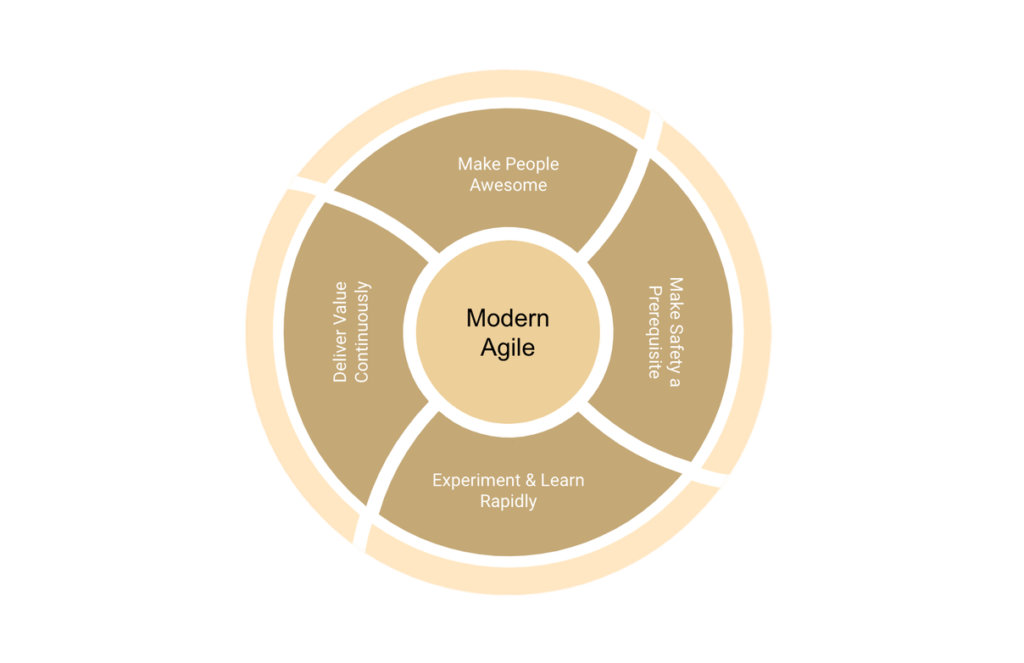In the past years, many companies have adopted Agile methods. And it’s not just a fad: it really works.
But what does it mean for SEO?
Essentially, it means that SEO needs to adapt to the Agile approach as well. The good news is, it brings along many benefits for SEO projects. Agile methods help to adapt quickly to changes in search and user behavior, leading to better results. Let’s explore how agility can improve SEO strategies.
What is Agile?
In simple words, “Agile” in project management is an ability to adapt to constantly changing circumstances. It involves breaking down complex tasks into smaller, manageable chunks, and continuously iterating and improving based on feedback and new requirements.
Agile encourages teams to embrace change, respond quickly to new information, and deliver value to customers faster. It’s not just a set of processes or tools; it’s a mindset—a way of working that empowers individuals and teams to thrive in an ever-changing world.
Agile is based on the 12 principles defined in the “Agile Manifesto” created by 17 developers in Utah in 2001.
What are modern Agile principles, and how do they apply to SEO?
While there are 12 main principles in traditional Agile, I would like to focus on the 4 principles of “Modern Agile”, which is a simplified version formed over the past decade.

1. Make People Awesome
The first principle of Modern Agile is “make people awesome”. It means empowering anyone involved in the project cycle (team members, users, stakeholders) to feel supported to reach their full potential.
Let’s see what it means for different groups of people.
Make Users Awesome
SEO should be about customers and satisfying the pain points of people who use Google to find what they need. When we do SEO, it is important to think about the needs of the end user, not only Googlebot.
Keyword research and content gap analysis are great ways to find out what important information your website lacks, which could fulfil the needs of potential customers. However, just creating pages and sections optimized with those keywords is not enough. It is important to find out what the users look for and think about the ways to improve their experience of search.
The pages need to:
- Provide maximum value and match the user’s search intent
- Be user-friendly and have high-quality content (Consider asking someone from UX for help.)
- Load fast and have optimized CWVs
Make Teammates Awesome
Another important part of this principle is ensuring that team members working on SEO are motivated and understand the reasons behind their tasks. It’s vital to dedicate time and resources to clarify the purpose of each action, its expected outcome, and to share the results once completed.
Here are a few aspects to consider:
- Autonomy: Provide team members with the autonomy to make decisions and take ownership of their work. Encourage them to share ideas, experiment and take calculated risks.
- Support and Resources: Make sure that team members have access to the resources, tools, and training they need to work on the project.
- Recognition and Feedback: Acknowledge and celebrate the achievements of team members and provide constructive feedback.
- Collaboration: Create a collaborative environment where team members can share knowledge and learn from one another. Encourage cross-functional collaboration with other teams, such as content creators, developers, and marketers, to leverage diverse points of view.
Make the stakeholders awesome
Another important aspect of agile SEO is making sure that stakeholders understand and are motivated to drive SEO efforts. Just as team members need clear guidance, stakeholders require education and alignment with SEO goals. Keep in mind that they have their own priorities and KPIs. It is important to understand them, adapt the strategy and address the pain points.
- Clear Communication: Don’t use complex terms and concepts when you talk about SEO. Make sure your audience understands everything, and it not just intimidated to ask what is a “SERP”.
- Education and Awareness: Educate stakeholders about SEO, its contribution to the business success, and its potential to drive measurable results.
- Alignment with Business Goals: Align SEO initiatives with business objectives and priorities. For example, driving visits or leads to an important category.
- Regular Updates and Reporting: Make sure the stakeholders know what is going on and how they can help you.
- Recognition and Appreciation: Acknowledge the contributions of stakeholders to the success of SEO initiatives.
2. Make Safety a Prerequisite
Making people feel safe is fundamental in Agile. Let’s see what it means:
Make Team Members feel safe
The feeling of safety allows team members to share their ideas and experiment freely without being scared of judgement.
In modern SEO, just following optimization checklists is no longer enough and can even be harmful. So if your coworkers have some fresh ideas, it’s important to listen to them without judgement and assess their value.
In my experience, anyone from a salesperson to a backend developer can have awesome ideas on how to improve SEO. And people really appreciate when they get a chance to share them and get honest feedback.
Make Users feel safe
Making users feel safe is one of the priorities Google has been following in its algorithm update for the past years. So you probably know what to do here: use secure protocol, follow E-E-A-T, avoid black hat tactics, and prioritize user experience.
Make Stakeholders feel safe
By prioritizing safety and transparency in your relationship with stakeholders, you can build trust and confidence, leading to a more effective collaboration.
Consider doing the following:
- Educate on SEO Risks: Provide stakeholders with a clear understanding of the potential risks such as algorithm updates, competitors actions, consequences of black hat strategies and human errors.
- Communicate Algorithm Updates: Keep stakeholders informed about search engine algorithm updates and their potential impact on SEO performance. Demonstrate that even though you can’t predict the outcome, you are in control of analysing the situation and defining the next steps.
- Set Realistic Expectations: Avoid overpromising or guaranteeing immediate results, and emphasize the importance of long-term, sustainable growth.
- Provide Transparency: Keep them informed about the progress of SEO initiatives, challenges and setbacks, and the steps being taken to address them.
- Address Concerns and Questions: Take the time to listen to their feedback and provide clear explanations and solutions to address their concerns.
3. Experiment & Learn Rapidly
Without experimenting in SEO, we cannot be completely sure that chosen actions or strategies really work. Testing can help to discard irrelevant ideas and prioritize valuable tasks.
Before making significant changes to your entire website, try conducting experiments on smaller sections for 3-6 weeks. Learn from these experiments, and then decide whether to proceed with the changes or revert them. This approach allows you to refine your strategy based on data-driven insights.
4. Deliver Value Continuously
The “deliver value continuously” principle highly correlates to the experimentation rule. It means using iterative and incremental approaches for developing and executing SEO strategies.
- Break down the SEO strategy into smaller tasks or sprints. For instance, if you’re optimizing Core Web Vitals, include 2-3 small tasks in each sprint instead of tackling one big action for several months.
- Consider using the MVP (minimum viable product) approach. Start with a simplified version of your project to evaluate the idea and its outcomes before investing heavily. For instance, if you’re creating a long-tail listing page, start with basic features and add more later if it attracts enough SEO traffic.
- Identify high-impact SEO tasks that can deliver value quickly and prioritize their implementation. Focus on actions with the highest potential impact in both the short and long term.
Agile vs Traditional Approach to SEO
Now that we’ve seen the Modern Agile principles, let’s compare it to the traditional approach to SEO projects.
- Project Management and Planning
In traditional SEO, the usual approach involves spending a couple of months conducting a comprehensive SEO audit, creating a detailed list of tasks, and planning their execution over the following months.
On the other hand, Agile SEO adopts an iterative and incremental approach. Projects are broken down into smaller, more manageable tasks or sprints, with a focus on continuous improvement and adaptation based on feedback and data.
- Flexibility
In traditional SEO, it’s common to have extensive documentation prepared before the project launch, providing rigid instructions for every step.
In Agile SEO, teams have the space and opportunity to adjust their actions in the middle of the project based on the feedback they receive, new market trends, or competitors’ actions. The final project can differ significantly from the initial plan.
- Collaboration and cross-functional projects
In the traditional approach, SEO may be performed in a siloed department with limited communication with other teams. This can lead to friction with other areas, such as UX designers complaining about SEOs disrupting their lean designs with their ugly texts or content creators believing SEO articles have no value for users.
Agile promotes cross-functional teamwork, involving collaboration between different profiles and teams, such as UX designers, marketing, content creators, developers, and business stakeholders. This helps to build an open communication and collaboration to achieve common goals.
- Speed of execution
Some SEO projects can be complex and require many months of work. In the traditional approach, the speed of implementation can be slow, as teams wait for everything to be perfect before launching it into production.
Agile utilizes the concept of MVP, where a simplified version of the page is launched first, followed by iterations. This allows for earlier feedback and adjustments.
- Data-driven decisions
In the traditional approach, SEOs often make assumptions about what will work based on experiences or best practices. In Agile, almost everything is measured and tested through A/B tests and MVPs. This enables teams to identify and address potential risks earlier in the process, reducing their impact on project outcomes.
Being agile in SEO is a great way to adapt to the constantly changing market and search engine situations and make your team more effective and motivated. So I hope that this article has been useful, and you will be able to apply some of these principles to your projects.
Daria Miroshnichenko
Note: this article contains only my personal research and opinion:)
Sources and recommended literature:

